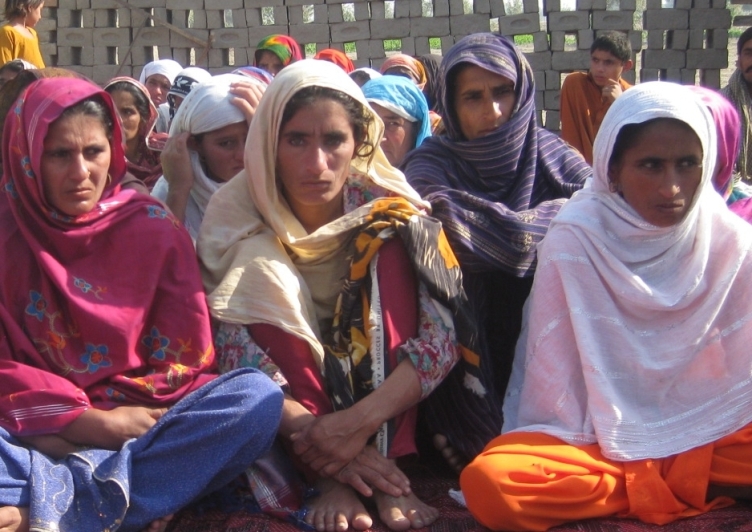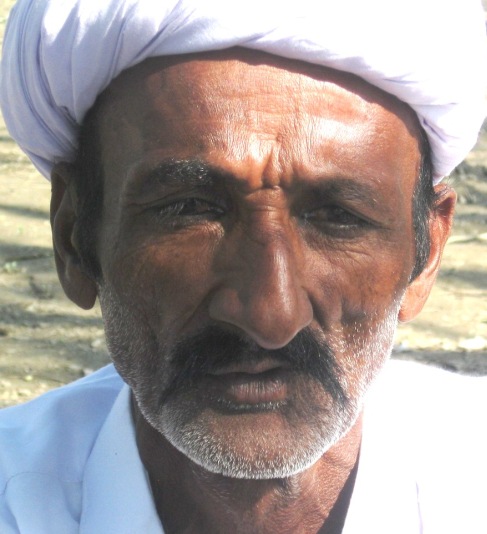
Seen from the air, the greenness and neat outlines of the farm fields in Punjab stand in sharp contrast with the Sindh Province, its much poorer and more desert-like neighbor to the south.
My colleague Susan Finucane and I are flying from Karachi on Pakistan's southern coast into the Punjabi city of Multan, an historically significant garrison town in the heart of the country that is today a well-kept, cleanly-swept bustling city. The relative privilege of the place and the orderliness of local traffic are a far cry from the chaos of urban streets that we have just left behind in Sindh.
The ordered lushness observed from altitude makes sense. Punjab is, literally, the 'land of five rivers': fertile, relatively affluent and crucial to Pakistan as a grower of wheat and other crops. A kind of cognitive dissonance takes hold.
Participants at a hygiene session in Abas Khan Photo: Concern Worldwide
Though it is not immediately evident from above, we know that the devastating floods of summer 2010 destroyed more than 1.7 million acres of crops. Punjab is still fertile but the planting and harvest cycles have been violently interrupted and, though the flood waters have mostly receded, the ravages of the disaster will be manifested drastically in reduced crop yields and threats of food shortage and disease.
Hundreds of villages were severely affected, leaving up to 6 million people in need of various forms of assistance. The picture gets clearer during a drive into the countryside, where many destroyed fields are in evidence. Far and wide, the crops -- cotton, wheat, corn -- lay abandoned, gray and wilted.
Imam Bakish, 50, heads an extended household of 14 in Basti Daryai. Photo: Concern Worldwide
We're traveling through the largely rural district of Muzaffargah, whose entire population of more than 2.6 million people had to be evacuated in the wake of the flooding. For the majority, it took up to eight weeks or more to be able to return to their villages, finding most of their homes destroyed, their property washed away and their livestock killed.
A limited effort by the government, as well as emergency response initiatives by international aid organizations, relied on roadside distributions, which left families vulnerable to attacks and fraudulent behavior of what locals refer to as "professional" beneficiaries. Predatory practices also included the purchase of surviving livestock at cut rates and taking advantage of families' urgent need to raise emergency cash.
For its part, Concern, banking on relationships with local NGO's built up and formalized in the past five years or more, was able to distribute emergency supplies in the villages, the heart of the communities themselves. "Our local partners are our ambassadors in the villages," said Nauman Shahzad, a Concern program officer based in Multan.
Working through these partner organizations, whose leadership often has family ties in the very villages they serve, Concern also insists on the engagement of the communities themselves in determining the eligibility of beneficiaries. As a result, communities take ownership of the aid efforts, keeping an eye on the most vulnerable families in their midst.
Such is the case for the hamlet of Abas Khan, which is part of the 150-household village of Basti Daryai, where, after distributing emergency shelter materials in the early going, Concern is currently overseeing a comprehensive water, sanitation and hygiene (WASH) program. Administered by the Doaba Foundation, the program is part of a comprehensive approach that aims to safeguard health in the immediate term, while phasing in longer term recovery programs that will address damage done to infrastructure and crops.
Susan and I were honored guests at a community meeting where several local leaders gave a low-tech but very thorough and impressive overview of the program -- hand-drawn charts and all.
The WASH program consists of latrines connected to septic tanks, hand-wash stations and hand-pumps replacing older pumps, some of which could not tap water deep enough to bypass polluted levels, while others were stolen after the 30-family hamlet's initial evacuation. Strategically-placed brightly illustrated posters instruct locals about the benefits of hygiene, while a community-based WASH committee organizes regular refresher courses in the improvised village square.
Naseem presents Susan Finucane, Concern Worldwide Program Officer, with handicraft items made from straw found by the river. Photo: Concern Worldwide
The program has dramatically changed the lives of the local families, even as, naturally, their priorities are the reconstruction of their homes and the resumption of agriculture. "Before, we had given little thought to hygiene in the home and in our environment," says Imam Bakish, 50, who is in charge of an extended household of 14, including his wife Pathanimai and nine children. "Our lives are much changed today," he adds, "we keep our bodies and our clothes clean, and children are less frequently ill and adults are doing better as well." In past years, diseases caused by unsafe water prompted costly and burdensome journeys to obtain health care.
"There has been such a great change," says Naseem, a 30-year-old mother of six. "We have gone to more than four [hygiene] sessions and are learning so much. The program has helped us a lot and made the village very happy."
Naseem and Imam, whose farming tools were destroyed by the floods that also made their customary plots inaccessible, long to return to work the land -- Imam as a farmer and Naseem as a cotton picker. Only then will their families have a shot at building a new home.
For now, their prospects are good. The land now being reclaimed from the water will actually be more fertile than before. The flood waters deposited another layer of soil richly-endowed with minerals that had been carried along as the flooding made its way down the north-south axis of the country. Concern and its local partners are accordingly shifting focus and resources to livelihoods recovery and reviving agriculture across the district.


